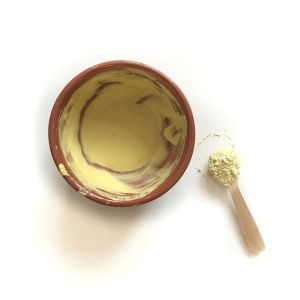How to make a Thanaka Powder Mask
Thanaka is a new ingredient for me. I came across it when browsing instagram and became instantly intrigued. But what is this powder and where did it originate?
What is Thanaka Powder?
Thanaka powder mixed with water.
Thanaka, or Limonia acidissima or Hesperethusa crenulata is a common tree in Southeast Asia and is used for its medicinal purposes throughout the region. It is commonly known as the sandalwood, applewood and monkey fruit tree. It is indigenous to Myanmar and has been used as a cosmetic product by the Myanmaris for over 2000 years, as a sun protectant, for skin decoration and also to cool the skin. The fruit is very high in protein as well as vitamins and minerals and is used to make a local beverage. Concoctions are made from the fruit to treat digestive problems as well as other ailments.
The powder comes from the bark of the tree which is ground into a fine powder. When used it is mixed into an opaque yellow paste with a small amount of water and is used as an astringent, antiseptic, antifungal, anti-aging, cosmetic and sun protectectant and to prevent acne. As with many traditionally used medicinal plants, Thanaka's chemical properties have been studied. Thanaka contains two active ingredients: coumarin and marmesin. The presence of coumarin explains it's anti-bacterial, anti-fungal, anti-inflammatory and antioxidant properties, which make it good for treating acne and other skin conditions. Interestingly, it is used predominantly as a sun protectant. Seiverling et al found that presence of marmesin made it a pretty efficient UVA absorber when compared with titanium dioxide. It has also been found to have skin brightening properties which are attributed to arbutin, also found in the bark powder.
What is it like?
I had mine shipped all the way from Thailand. I mixed it with a small amount of water and applied it to my face. It made a very smooth, creamy yellowish paste. On application, it did have a very cooling effect and even when it dried, it did not feel particularly uncomfortable to wear. It is supposed to have a fragrance but I found it to be neutral in scent. Surprisingly, it washed off very easily once it had dried, unlike clay masks that take an age to remove if left on too long. I can't say I noticed anything particularly different about my skin afterwards, except that it did not feel taught and my skin wasn't pink after application, as is normally the case with clay masks. I think I might need to use the mask for a while before making my final judgement but from first use, I would probably say this would be the perfect mask for sensitive skin. Here is another easy mask formula you could try:
Thanaka and Honey Soothing and Hydrating Mask
To make enough for one application follow the 'grams' column.
Ingredient Grams %
Thanaka Powder 9 24.5
Honey 25 67.5
Glycerin 3 8
Method:
Simply weigh and mix together in a bowl and apply. Leave it on until it dries. Its not like a clay mask, it can be left on over 10 minutes as it is not likely to cause any irritation or discomfort. I left mine on for far too long as I forgot it was there :-)
xoxoxo
References
Wangthong S
1
, Palaga T, Rengpipat S, Wanichwecharungruang SP, Chanchaisak P, Heinrich M,
Biological activities and safety of Thanaka (Hesperethusa crenulata) stem bark.,
J Ethnopharmacol.
2010 Nov 11;132(2):466-72. doi: 10.1016/j.jep.2010.08.046. Epub 2010 Sep 6.
Anne Goldsberry MD MBA,
a
Alan Dinner PhD, and C. William Hanke MD MPH
a,
Thanaka: Traditional Burmese Sun Protection, March 2014 | Volume 13 | Issue 3 | Original Article | 306 | Copyright © 2014
Elizabeth V. Seiverling, MD1, Alyssa M. Klein MD1, Lindsay C. Bacik BS1, Christoph Gelsdorf MD2and Hadjh Ahrns MD3, Sun protection and other uses of Thanakha in Myanmar


